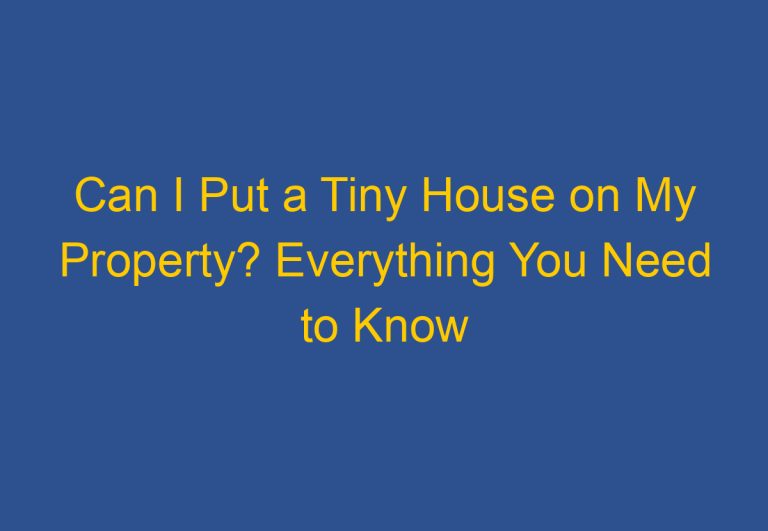Can I Buy Land and Build a Tiny House? Exploring Your Options
The tiny house movement has gained popularity in recent years as people look for ways to live a more minimalist lifestyle. One question that often arises is whether it is possible to buy land and build a tiny house. The answer is yes, it is possible, but there are some important considerations to keep in mind.
First and foremost, it is important to research local zoning laws and building codes before purchasing land for a tiny house. Some areas may have restrictions on the size and type of homes that can be built, and it is important to ensure that your plans are in compliance with local regulations. Additionally, it is important to consider the cost of utilities, such as electricity and water, as well as any necessary permits or fees that may be required for building a new home.
Despite these considerations, many people have successfully purchased land and built their own tiny homes. By taking the time to research and plan carefully, it is possible to create a unique and fulfilling lifestyle that is both affordable and sustainable.
Understanding Zoning and Building Regulations
Navigating Zoning Laws for Tiny Houses
When considering building a tiny house, it is important to understand local zoning laws and regulations. Zoning laws can vary significantly from one location to another, and some areas may have specific ordinances addressing the minimum square footage for residential structures or provisions for accessory dwelling units (ADUs). It is advisable to do thorough research and seek professional advice from a real estate agent or attorney to ensure compliance with local zoning regulations.
Securing the Right Location
One of the most important factors to consider when building a tiny house is location. Before purchasing land, it is essential to verify local zoning regulations to confirm if tiny houses are allowed in the area. Some regions have restrictions on minimum square footage or dwelling types. It is also important to ensure the land has access to essential utilities such as water, electricity, and sewage systems. Websites like Zillow, Land and Farm, and Lands of America can help you find land for sale in your desired location.
Complying with Building and Safety Standards
When building a tiny house, it is important to comply with building and safety standards. Building codes and regulations vary from state to state, and it is advisable to consult with a professional contractor or architect to ensure compliance with local building laws. Additionally, obtaining permits and using quality construction materials and tools is essential for building a safe and durable tiny house.
In summary, understanding zoning and building regulations is crucial when considering building a tiny house. By navigating zoning laws for tiny houses, securing the right location, and complying with building and safety standards, individuals can ensure a successful and legal building process.
Acquiring Land and Preparing for Construction
Before building a tiny home, it is important to acquire suitable land and prepare for construction. This section will cover the essential steps to finding and buying land, setting up necessary utilities, and planning your tiny home build.
Finding and Buying Suitable Land
The first step in building a tiny home is to find and buy suitable land. One option is to work with a real estate professional who specializes in land purchases. Websites like LandWatch, Craigslist, and Facebook can also be useful resources for finding available land.
When looking for land, it is important to consider the upfront costs, financial investments, and cost considerations. It is also important to consider the environmental impact of the land and any zoning restrictions or regulations that may impact the build.
Once a suitable piece of land has been identified, it is important to conduct a property survey and soil and water tests to ensure that the land is suitable for construction. Engineering services may also be necessary to ensure that the land can support the weight of the tiny home.
Setting Up Essential Utilities
After acquiring land, the next step is to set up essential utilities. This includes hooking up water, power, and sewage. If building an off-grid tiny home, alternative methods for obtaining these utilities will need to be considered.
It is important to consider the infrastructure of the area, including roads and network access, when setting up utility connections. A measuring wheel can be useful for measuring distances and property lines during this process.
Planning Your Tiny Home Build
Once the land and utilities have been acquired, it is important to plan the tiny home build. This includes creating a floor plan and considering any environmental impact the build may have.
To save money, it may be beneficial to consider off-grid living and alternative methods for obtaining power and water. It is also important to consider the cost of the build and any financial investments that may be necessary.
Overall, acquiring land and preparing for construction is an essential step in building a tiny home. By following these steps and working with professionals when necessary, a tiny homeowner can successfully build their dream home.
Frequently Asked Questions
What are the zoning regulations for building a tiny house on purchased land?
Zoning regulations for building a tiny house on purchased land vary depending on the location. It is important to research the zoning laws in your area before purchasing land to ensure that you can legally build a tiny house on it. Some areas may have specific restrictions on the size of the house or the type of foundation it can be built on. Contacting your local zoning office can provide you with more information.
How much does it typically cost to prepare land for a tiny house?
The cost of preparing land for a tiny house can vary depending on the condition of the land and the specific needs of the house. Some factors to consider include the cost of clearing the land, installing utilities such as water and electricity, and preparing the foundation. It is important to budget for these costs when considering purchasing land for a tiny house.
Are there any states with particularly tiny-house-friendly laws?
Yes, there are some states that are more welcoming to tiny houses than others. For example, in California, some cities have passed ordinances allowing for the construction of tiny houses. Oregon, Colorado, and Texas also have laws that make it easier to build and live in tiny houses. However, it is important to research the specific laws in your area before purchasing land for a tiny house.
What should be considered when looking for land to place a tiny house?
When looking for land to place a tiny house, it is important to consider factors such as zoning laws, access to utilities, and the condition of the land. It is also important to consider the location of the land and whether it is close to necessary amenities such as grocery stores and medical facilities. Additionally, it is important to consider the cost of the land and any additional costs associated with preparing it for a tiny house.
What permits are needed to build a tiny house on my own land?
The permits needed to build a tiny house on your own land can vary depending on the location and size of the house. Some areas may require building permits, while others may require permits for specific aspects of the construction such as electrical or plumbing work. It is important to research the specific permits required in your area before beginning construction.
Can I legally live full-time in a tiny house on my own property?
Whether or not you can legally live full-time in a tiny house on your own property depends on the zoning laws in your area. Some areas may allow for full-time living in a tiny house, while others may only allow for temporary or seasonal living. It is important to research the specific laws in your area before making plans to live in a tiny house full-time.










